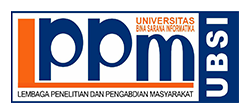Analisis Tingkat PenerimaanMahasiswa TerhadapAplikasi Zoom Meeting Sebagai Media Perkuliahan Menggunakan Metode TAM
DOI:
https://doi.org/10.31294/paradigma.v24i1.973Keywords:
Analysis, TAM, ZoomAbstract
The increasingly advanced technology makes it easier for anyone to use it for various activities, such as lecture activities. Especially during the Covid-19 pandemic that has occurred since 2019 until this research was conducted. Covid-19, formerly known as SARS-CoV2, is an outbreak of pneumonia that originates from a virus. This virus was first heard in Wuhan, China in December 2019 (Ciotti et al., 2020). Lectures are conducted online to prevent the spread of this virus. One of the technologies widely used during the Covid-19 pandemic is video conferencing. With video conference meetings can be held even if the people present are far from each other. Zoom is a cloud-based application that is currently often used as a video communication (Azkiya, 2021). Zoom is a video conferencing application that is currently being used in various activities, including lectures. Because it is important to know how much student acceptance of the Zoom application they use for lectures is. The research was conducted using the Technology Acceptance Model or TAM method which consists of three constructs, namely Perceived Usefulness, Perceived Ease of Use and Acceptance of Technology. The data was obtained by distributing questionnaires with a Likert scale of 1 to 5. The data obtained were then calculated using the Structural Equation Model or SEM method consisting of the Outer Model and Inner Model calculations. SEM is an analytical technique that allows testing of a series of simultaneous relationships (Gardenia, 2018). The conclusion is that by taking the R-Square value, the construct in the TAM method is able to measure as much as 63% of student admission case studies on Zoom as a lecture medium.
Keywords: Analysis, TAM, Zoom.
References
Andi Setiawan, M., & Suci Maghfirah, I. (2021). Efektivitas Aplikasi Zoom Dalam Proses Pembelajaran Matematika. Bitnet: Jurnal Pendidikan Teknologi Informasi, 6(1), 33–37. https://doi.org/10.33084/bitnet.v6i1.2565
Azkiya, F. (2021). Cara Mudah Menggunakan Zoom. Inoffast Publishing Indonesia. https://books.google.co.id/books?id=dhFBEAAAQBAJ
Ciotti, M., Ciccozzi, M., Terrinoni, A., Jiang, W. C., Wang, C. Bin, & Bernardini, S. (2020). The COVID-19 pandemic. Critical Reviews in Clinical Laboratory Sciences, 0(0), 365–388.https://doi.org/10.1080/10408363.2020.1783198
Gardenia, Y. (2018). Metode Structural Equation Model (SEM) Pada Pengukuran Kualitas Website Pemesanan Makanan Online. JSI (Jurnal Sistem Informasi), 54–62.
Hidayat, A. R., & Junianto, E. (2017). Pengaruh Gadget Terhadap Prestasi Siswa SMK Yayasan Islam Tasikmalaya. 4(2), 163–173.
Kusumaningtyas, R. H., & Rahajeng, E. (2017). PERSEPSI NASABAH AKAN LAYANAN ATM DAN E-BANKING DENGAN METODE TAM. Studia Informatika: Jurnal Sistem Informasi, 10(2). https://doi.org/10.1090/s0002-9939-02-06464-x.
Rahman, F., & Islam, A. (2021). Exploring paratransit service quality based on low-income women’s perception: A case study in Dhaka city by structural equation model (SEM). IATSS Research. https://doi.org/10.1016/j.iatssr.2021.11.009
Rozi, I., & Syarifudin. (2020). Pembelajaran Keterampilan Berbahasa Dengan Media Audio Visual Melalui Zoom Cloud Meeting Di Fakultas Tarbiyah Iai Qamarul Huda Bagu. Journal of Chemical Information and Modeling, 11(9), 1689–1699.
Setia, D. P. (2016). Analisis Penerimaan Sistem Informasi Pengolahan Data Statistik Rutin (Sisr )Menggunakan Metode Technology Acceptance Model (Studi Kasus: Bkkbn Provinsi Riau). Journal of Chemical Information and Modeling, 53(9), 1689–1699.
Subekti, H. A., Nubaiti, Masilawati, & Happy Fitria. (2020). Pemanfaatan Video Conference Sebagai Media Permbelajaran Interaktif Pada Mata Pelajaran Produktif Di Sekolah Menengah Kejuruan. Prosiding Seminar Nasional Pendidikan Program Pascasarjana Universitas Pgri Palembang 10 Januari 2020 Pemanfaatan, 427–437.
Downloads
Published
How to Cite
Issue
Section
License
Copyright (c) 2022 Muhammad Ifan Rifani Ihsan, Rabiatus Sa’adah, Rizka Dahlia, Badariatul Lailiah, Hendri Mahmud Nawawi

This work is licensed under a Creative Commons Attribution-ShareAlike 4.0 International License.
Paradigma is an open-access article distributed under the terms of the Creative Commons Attribution-ShareAlike 4.0 International License (https://creativecommons.org/licenses/by-sa/4.0/) , This license permits: Share — copy and redistribute the material in any medium or format for any purpose, even commercially, Adapt — remix, transform, and build upon the material for any purpose, even commercially.




















 Jl. Kramat Raya No.98, Kwitang, Kec. Senen, Kota Jakarta Pusat, DKI Jakarta 10450
Jl. Kramat Raya No.98, Kwitang, Kec. Senen, Kota Jakarta Pusat, DKI Jakarta 10450
